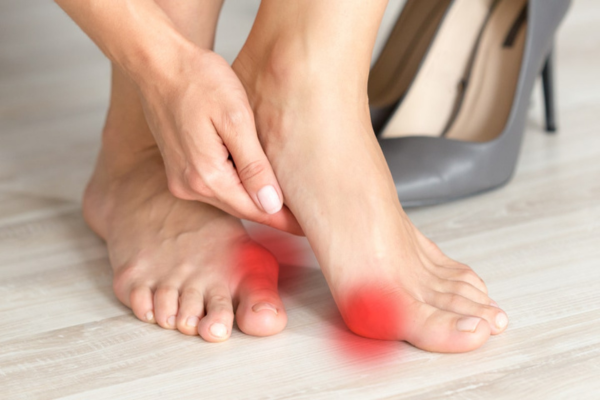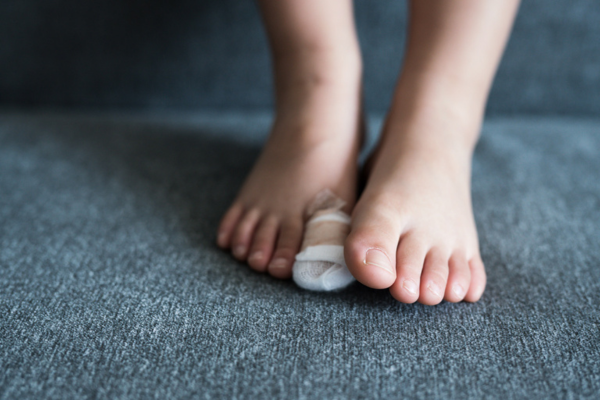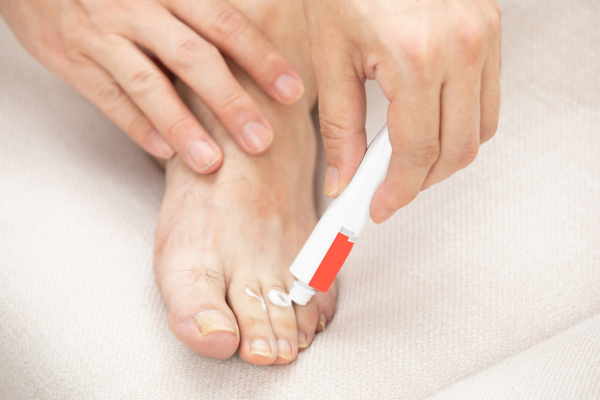From tight- befitting footwear to indecorous trimmng ways, from toe injuries to inheritable tendencies, the factors at play are different and nuanced. In this disquisition, Nghia Nippers will claw into the intricate details of what causes ingrown toenails, slipping light on the multifaceted nature of this condition and the way individualities can take to guard their bottom health.
1. The main cause of ingrown toenails
The causes of ingrown toenails are multifaceted, encompassing both external influences and internal physiological factors. Let's claw deeper into each of these causes to gain a comprehensive understanding.
1.1 Improper trimming
One of the primary culprits behind ingrown toenails lies in the realm of nail care practices. Improper trimming techniques, characterized by cutting nails too short or rounding them at the edges, create a breeding ground for ingrown toenails to take root. When nails are trimmed improperly, they lose their natural shape and integrity, leaving them susceptible to abnormal growth patterns. As the nail attempts to regrow, it may veer off course, growing into the surrounding skin instead of outward.

This misdirection not only causes discomfort but also creates an environment ripe for inflammation and potential infection. Hence, mastering proper nail trimming techniques becomes imperative in the battle against ingrown toenails. By adopting techniques that prioritize maintaining a straight edge and moderate nail length, individuals can effectively safeguard against the onset of ingrown toenails and foster an environment conducive to healthy nail growth.
1.2 Tight shoes and socks
The relationship between footwear and ingrown toenails is a complex interplay of pressure, friction, and anatomical constraints. Ill-fitting shoes and socks, characterized by tightness and constriction, exert undue pressure on the toes, distorting the natural alignment of the nails. With each step, the nails are compressed against the skin, causing them to curve inward in response to the relentless force.

Over time, this continual pressure and friction create an environment ripe for ingrown toenails to flourish. Footwear with narrow toe boxes, such as high heels and snug-fitting shoes, exacerbate this issue by further restricting the toe's mobility and exacerbating the compression. As a result, individuals find themselves more susceptible to ingrown toenails, their toes confined within a suffocating environment that leaves little room for comfort or respite.
1.3 Toe injury
The journey toward ingrown toenails can often be precipitated by traumatic incidents that disrupt the delicate balance of nail growth. Whether it's a momentary lapse in coordination resulting in a stubbed toe or a more severe injury caused by dropping heavy objects, trauma to the toes can have far-reaching consequences. Such incidents not only inflict immediate damage but also disturb the natural growth pattern of the nails, setting the stage for ingrown toenails to manifest.

The aftermath of toe trauma may unfold in various ways: the nail may become ingrown immediately, ensnared by the surrounding tissue in a painful embrace, or it may gradually succumb to the forces of misdirection, veering off course with each subsequent growth cycle. In either scenario, vigilance in protecting the toes from injury emerges as a crucial imperative in the quest for optimal foot health. By minimizing exposure to potential hazards and prioritizing preventative measures, individuals can fortify their defenses against the insidious threat of ingrown toenails, ensuring that their toes remain resilient and unyielding in the face of adversity.
2. Objective causes
Assaying the objective causes of ingrown toenails, which claw into underpinning health conditions, provides a deeper understanding of the complications involved.
2.1 Diabetes
Diabetes, a habitual metabolic complaint characterized by high blood sugar situations, can significantly impact bottom health and contribute to ingrown toenails. One of the crucial complications of diabetes is supplemental neuropathy, a condition that damages the jitters in the extremities, including the bases. Neuropathy diminishes sensation in the bases, making it delicate for individuals with diabetes to describe early signs of ingrown toenails, similar to pain or pressure.
Also, diabetes can vitiate rotation, reducing blood inflow to the bases and compromising the body's capability to heal injuries and infections. The combination of neuropathy and poor rotation increases the threat of ingrown toenails progressing to more severe complications, similar as infections or ulcers.
2.2 Psoriasis
Psoriasis is a habitual autoimmune complaint characterized by inflammation and abnormal skin cell growth, which can affect colorful corridors of the body, including the nails. Psoriatic nail changes, known as nail psoriasis, frequently manifest as pitting, abrasion, thickening, or separation of the nail from the nail bed. These structural abnormalities can cause the nails to ingrow, as the irregular nail face may catch on the girding skin and access it. Likewise, the inflammation associated with psoriasis can complicate the discomfort and inflammation caused by ingrown toenails, leading to a vicious cycle of worsening symptoms.

2.3 Heredity
Genetics play a significant part in determining an existent's vulnerability to ingrown toenails.
Certain inherited traits, similar as the shape and structure of the toenails, can dispose individualities to ingrowth, anyhow of external factors like footwear or nail care practices. For illustration, individualities with naturally twisted or exorbitantly thick toenails may be more prone to developing ingrown toenails, as the curve or consistency of the nail can direct its growth into the girding skin.
Also, heritable conditions that affect nail growth, similar as nail dystrophy or natural nail abnormalities, can increase the liability of ingrown toenails being. Understanding the inheritable predilection to ingrown toenails can help individualities take visionary measures to help and manage the condition, similar as espousing applicable footwear and nail care practices.
The objective causes of ingrown toenails encompass a range of underpinning health conditions, including diabetes, psoriasis, and heritable factors. By exhaustively examining these factors, healthcare providers can develop acclimatized interventions to effectively help and manage ingrown toenails in affected individualities.
3. Avoiding ingrown toenails
Experts agree that ingrown toenails can be painful and may lead to an infection, so you probably want to help them. Ingrown toenails are a veritably common condition where the corner or side of your toenail grows into the meat of your toe. Ingrown toenails are more common in your big toe, but they can be to any toe. Research suggests that you might be suitable to help ingrown toenails by minding your toenails and wearing sturdy, comfortable shoes.
3.1 Do not trim your toenails too short
One of the main causes of ingrown toenails is trimming them too short. However, the pressure put on the ends of your toes while walking( particularly if your shoes are too tight) can drive the sharp edges of the nail into the girding towel, If you trim your toenails too short. As similar, keep toenails trimmed to a moderate length — so they are roughly indeed with the tips of your toes.
- Nails should be cut with a clean, sharp nail trimmer that is made for thicker toenails, rather than the lower bones that are more applicable for fingernails. Using a specialized nail clipper designed for toenails can help achieve a precise cut, reducing the risk of ingrown nails.
- Some people's toenails grow faster than others, but plan on trimming them every week or so.
- Poor sight, incapability to reach your toes due to belly fat, and/ or having especially thick nails can make it grueling to duly trim toenails.
- Make an appointment with a podiatrist( bottom specialist), If it's too delicate to trim your toenails.
>>> Read more: How to cut ingrown toenail
3.2 Trim your toenails straight across
Another major cause of ingrown toenails is trimming them at angles along the sides to match the rounded shape of your toe, which allows the skin to grow over the nail's sharp edge and get bothered. Similarly, trim them straight through, or tell your pedicurist to do them that way, and you will greatly reduce your threat of developing ingrown toenails, especially your big toes.
- Picking or tearing at the corners of your toenails can also beget them to come ingrown.
- Some people's toenails are naturally curved or fan-shaped, which predisposes them to developing ingrown nails.
- People who have particularly thick toenails have a lower threat of ingrown toenails because the nails do not erect the girding skin as fluently as thinner bones.

Investing in good toenail clippers can also contribute to proper trimming techniques and further decrease the likelihood of ingrown toenails.
3.3 Wear shoes that fit duly.
Shoes that pinch or place too important pressure on the ends of your toes can also beget a toenail to grow into the girding towel and come painful. Thus, take care to buy and wear duly fitted shoes, especially if the shoes are for sports that involve a lot of running and stopping, similar to soccer, basketball, football or tennis.
- Ask an educated salesman for a proper dimension/ fitting and some advice about which types are stylish for the shape of your bottom, If you are doubtful what size of shoes to wear.
- Wearing socks that are too thick can also crowd your toes and increase the threat of toe trauma and ingrown toenails.
- Shoes that are exorbitantly loose and too big can increase the threat of ingrown nails, especially in the big toe because sliding around is too important while walking and running.
3.4 Consider wearing defensive footwear.
However, also wear defensive footwear, similar as special sword- toed shoes or thrills, If your work puts you at significant threat of injuring your toes. Similar shoes or thrills will cover all of your toes from trauma, which increases the threat of ingrown and misplaced toenails — as most poorly injured bruised nails get discoloured and simply fall off.
- Jobs that warrant sword- toed shoes thrills include construction worker, plant worker, handyperson, welder, firefighter and demesne ranger.
- Always buy shoes and thrills made of permeable material, similar to leather and suede, because sweaty bases make the skin around your toenails soft and easier to pierce. In addition, wearing socks that help wick humidity down from the bases are helpful as well.
3.5 Be careful not to end your toes

Trauma to the ends of your toes generally causes swelling, which pushes the soft towel into the edges of the sharp nails and increases the threat of ingrown toenails. Similarly, be careful walking around your home and consider wearing some hard toed slippers or " house shoes" for added protection just in case.
- The legs of tables, chairpersons and beds are the most generally snubbed pieces of cabinetwork.
- The big toe and the lowest( 5th) toe are the bones most likely to get snubbed and injured.
- Other precautionary measures include making sure your bottom is free of clutter, removing slippery hairpieces, and wearing your spectacles or connections if you need them to see easily.
3.6 See a podiatrist on occasion
However, see a croaker or podiatrist for help and treatment on a regular basis( every three to six months), If you have trouble duly taking care of your toenails or if you have diabetes. Diabetes leads to poor rotation and reduced sensation in the bases, which hampers your capability to feel if your toes are inflamed or if your shoes are too tight. Your podiatrist can make special shoes or orthotics( shoe inserts) that accommodate your bases and reduce the threat of toe trauma and ingrown toenails.
- With diabetes, an ingrown toenail can come fluently infected and also turn into a bottom ulcer( delicate- to- heal open sore).
- bottom ulcers increase the threat of gangrene, which involves the death of towels from lack of blood rotation.
- Although people who give pedicures can frequently help with toenail trouncing, they're no cover for professionally trained bottom specialists.
4. Treating ingrown toenails at home
4.1 Soak your bottom in warm water
Ingrown toenails should be treated at home as soon as they're honored ( before infection sets in), in order to help complications and the need for medical treatment. One of the easiest styles is to soak the affected bottom in warm water for 15- 20 twinkles, three to four times daily. Soaking can reduce lumpiness and relieve tenderheartedness.
- Consider adding some Epsom swab to your bottom bath. It can help disinfect your ingrown toe and help soothe the pain and inflammation.
- Apply an ice cell to it for about five twinkles, If your ingrown toe is still inflamed after the bottom bath. The ice will numb the pain and combat the inflammation.
Additionally, using a cuticle nipper to carefully trim any excess skin or nail that may be exacerbating the ingrown toenail can help alleviate discomfort and prevent further irritation.
4.2 Apply some antibiotic cream
Apply antibiotic cream, embrocation or ointment to your ingrown toe at least a couple of times per day, particularly just before you go to bed in the evening. After the cream has absorbed into the soft towel girding the toenail, apply a girth. Make sure to change the girth each time you apply the antibiotic ointment.

4.3 Place a cotton ball or dental fluff under your ingrown toenail
After soaking your toenail in warm water and softening it up, put a piece of cotton ball or waxed dental fluff under its ingrown edge. This will relieve the pressure on the girding skin and help the toenail grow above the edge of the skin. Try wetting down the cotton with water and some antibiotic cream first before fitting.
- Don't essay this remedy unless directed to do so by a podiatry specialist.
- Consider putting some coconut oil painting on the inflamed skin beforehand to soften the skin and help reduce the lump. The cotton or dental fluff will also slide under the nail easier.
- Change the cotton or dental fluff on a diurnal base to keep the area antiseptic and to help a bacterial infection.
5. Conclusion
Incorporating these scrupulous cleaning and preventative measures into your regular bottom care routine serves as a necessary strategy in securing against the dreaded imminence of ingrown toenails. By nurturing bottom hygiene and prioritizing scrupulous care as Nghia Nippers guided above, individualities can effectively minimize discomfort and complications associated with ingrown nails, thus addressing what causes ingrown toenails, and ultimately, icing sustained bottom health and overall well- being.
>>> See more: How to cut toenails













